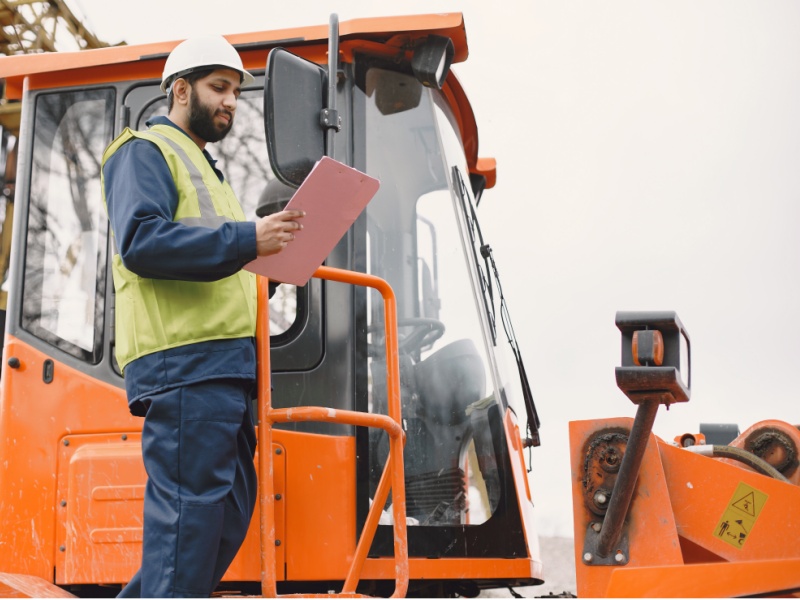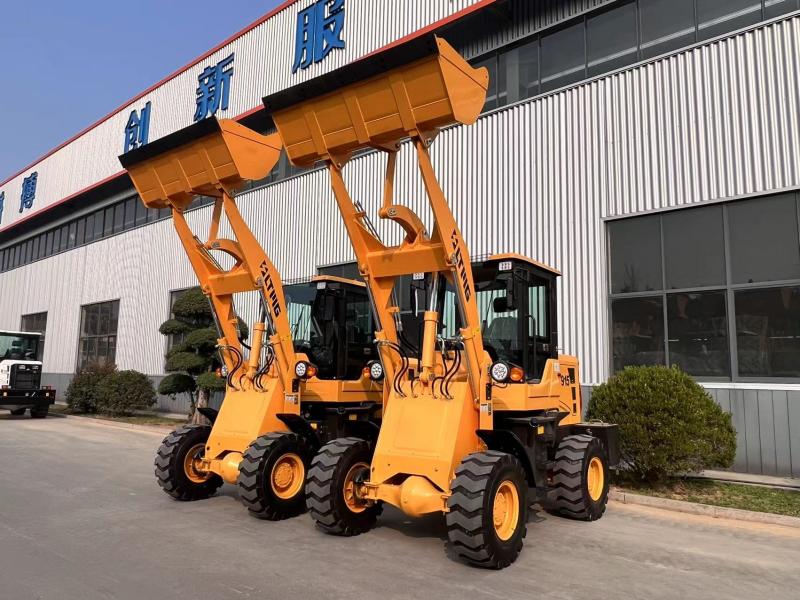Jaga Peralatan Anda Tetap Berjalan Efisien: 5 Masalah Umum Loader dan Cara Mengatasinya dengan Cepat
Jul 22, 2025
Pemuat roda merupakan peralatan inti yang penting di lokasi konstruksi, pertambangan, pertanian, dan pelabuhan. Mereka melakukan pekerjaan pemuatan, pemindahan, dan pembersihan berat setiap hari. Namun, layaknya mesin yang bekerja keras, loader pasti akan menghadapi berbagai masalah. Mengidentifikasi dan mengatasi masalah-masalah ini tepat waktu tidak hanya akan meminimalkan waktu henti yang mahal, tetapi juga memastikan pengoperasian yang aman dan memperpanjang umur peralatan. Artikel ini akan membahas secara mendalam 5 masalah loader yang paling umum dan memberikan solusi yang jelas dan praktis untuk membantu Anda menjaga peralatan Anda tetap berkinerja terbaik. Masalah 1: Respon Transmisi Lambat atau Selip (Masalah Transmisi)Transmisi adalah inti dari sistem tenaga pemuat, dan kesehatannya secara langsung memengaruhi kemampuan perjalanan dan operasi peralatan. Gejala Umum:Gejala umumnya antara lain perpindahan gigi yang sulit, benturan keras, gigi selip atau listrik padam saat berkendara, suara dengungan atau derit yang tidak wajar dari transmisi, serta suhu oli transmisi yang tinggi dan alarm dasbor. Akar penyebabnya:Akar permasalahannya meliputi masalah oli, seperti level oli transmisi rendah, kontaminasi oli, atau penggunaan jenis oli yang salah; penyumbatan filter, yaitu filter transmisi tidak diganti dalam waktu lama sehingga mengakibatkan sirkuit oli tersumbat; keausan internal, seperti keausan komponen internal seperti pelat kopling, pelat gesekan, atau roda gigi; dan kegagalan kontrol elektronik, yaitu kegagalan katup kontrol atau katup solenoida, sehingga perintah perpindahan gigi tidak dapat dijalankan dengan benar. Solusi:Periksa oli secara teratur: Periksa level oli transmisi setiap hari dan ganti oli transmisi serta elemen filter sesuai siklus yang direkomendasikan produsen. Ini adalah tindakan pencegahan yang paling mendasar dan penting.Gunakan oli yang tepat: Pastikan untuk selalu menggunakan oli transmisi khusus yang memenuhi spesifikasi peralatan.Perhatikan pembersihan: Jaga transmisi dan radiator tetap bersih untuk memastikan kinerja pembuangan panas yang baik.Diagnosis profesional: Jika masalah berlanjut, terutama yang melibatkan kebisingan internal atau selip parah, segera hentikan operasi dan hubungi teknisi profesional untuk pemeriksaan guna menghindari perluasan kesalahan. Masalah 2: Kegagalan Sistem HidrolikSistem hidrolik adalah "otot" loader, yang bertanggung jawab atas semua tindakan utama seperti mengangkat boom dan membalik bucket. Gejala umum:Kecepatan mengangkat boom atau membalik bucket melambat secara signifikan. Meskipun putaran mesin tinggi, daya angkat terasa kurang. Pompa hidrolik mengeluarkan suara siulan yang tajam. Terdapat tanda-tanda kebocoran oli yang jelas pada sambungan pipa oli hidrolik atau silinder, dan suhu oli hidrolik terlalu tinggi. Akar permasalahan:Kontaminasi oli adalah penyebab utama kegagalan sistem hidrolik. Debu, kelembapan, atau partikel logam yang masuk ke dalam oli akan cepat merusak pompa, katup, dan silinder; penyumbatan elemen filter, yaitu elemen filter oli hidrolik (termasuk elemen filter oli hisap dan balik) tersumbat, sehingga mengakibatkan pasokan oli tidak mencukupi; level oli terlalu rendah, yaitu level oli di tangki oli hidrolik lebih rendah dari standar, menyebabkan sistem menghirup udara. Komponen inti aus, seperti keausan pompa hidrolik, katup kontrol utama, atau seal internal silinder, yang mengakibatkan kebocoran internal dan ketidakmampuan untuk membangun tekanan. Solusi:Jaga kebersihan oli: Ganti oli hidrolik dan semua elemen filter secara berkala. Saat menambahkan atau mengganti oli hidrolik, pastikan lingkungan dan peralatan di sekitar tetap bersih.Pemeriksaan harian: Periksa level oli hidrolik sebelum memulai pekerjaan setiap hari, periksa semua pipa dan sambungan hidrolik, dan tangani kebocoran tepat waktu.Hindari kelebihan beban: Operasi kelebihan beban jangka panjang akan mempercepat keausan pompa dan katup hidrolik.Uji tekanan profesional: Jika terdapat kelemahan dalam pergerakan, mintalah teknisi untuk menggunakan pengukur tekanan profesional untuk menguji tekanan sistem guna menemukan titik kerusakan secara akurat. Masalah 3: Kesulitan menghidupkan mesin atau asap hitam (Masalah Mesin)Mesin merupakan jantung dari loader, masalah apa pun pada mesin dapat menyebabkan peralatan berhenti total. Gejala umum:Gejala yang umum terjadi antara lain sulit dihidupkan saat mesin dingin atau panas, memerlukan beberapa kali percobaan, tenaga tidak mencukupi saat bekerja, terasa "lemah", asap berwarna tidak normal keluar dari pipa knalpot (asap hitam: pembakaran tidak sempurna; asap biru: oli terbakar; asap putih: bahan bakar mengandung air atau pendingin masuk ke dalam silinder), dan suhu air mesin terlalu tinggi, atau ada bunyi ketukan tidak normal saat dijalankan. Akar penyebabnya:Akar permasalahannya meliputi sistem bahan bakar, seperti filter solar yang tersumbat, atomisasi injektor yang buruk, atau kualitas bahan bakar yang buruk; pada sistem pemasukan, filter udara sangat tersumbat, sehingga mengakibatkan pemasukan udara tidak mencukupi; pada sistem pendingin, radiator tersumbat, termostat rusak, atau cairan pendingin tidak mencukupi, sehingga mengakibatkan mesin menjadi terlalu panas; ada pula masalah pada sistem pelumasan, yaitu tekanan oli rendah atau oli tidak mencukupi. Solusi:Lakukan perawatan secara ketat: Sesuai dengan buku petunjuk perawatan, gantilah "tiga filter" (filter mesin, filter diesel, filter udara) dan oli mesin tepat waktu.Pastikan kualitas bahan bakar: Tambahkan solar yang bersih dan berkualitas dari saluran reguler.Jaga radiator tetap bersih: Gunakan udara bertekanan secara teratur untuk meniup debu dan kotoran di permukaan radiator.Perhatikan dasbor: Selalu perhatikan indikator utama seperti pengukur suhu air dan pengukur tekanan oli, dan segera hentikan mesin untuk diperiksa jika ditemukan kelainan. Untuk masalah seperti asap hitam, biasanya dimulai dengan memeriksa filter udara dan filter solar. Masalah 4: Keausan atau kerusakan ban yang berlebihan (Masalah Ban/Roda)Ban adalah satu-satunya bagian loader yang bersentuhan dengan tanah, dan kondisinya secara langsung memengaruhi traksi, stabilitas, dan bahkan keselamatan operasional peralatan. Gejala umum:Keausan pola tapak ban yang tidak merata, seperti keausan berlebih pada bagian tengah, samping atau sebagian, retakan dan tonjolan pada dinding samping ban, atau tusukan tapak oleh benda tajam, benturan yang tidak wajar atau guncangan bodi saat berkendara, seringnya tekanan ban turun, sering perlu pengisian udara, baut hub roda longgar atau berubah bentuk, serta retakan pada velg. Akar penyebabnya:Tekanan ban yang tidak tepat. Tekanan ban yang terlalu tinggi akan memperparah keausan di bagian tengah tapak. Tekanan ban yang terlalu rendah akan menyebabkan keausan di kedua sisi dan meningkatkan risiko ban meletus. Beban berlebih dalam jangka panjang, yaitu penggunaan terus-menerus melebihi beban terukur, akan menyebabkan tekanan yang sangat besar pada struktur ban. Kondisi kerja yang keras, yaitu sering berkendara di atas batu tajam, puing konstruksi, atau tanah yang tidak rata. Kebiasaan berkendara yang buruk, seperti tikungan tajam, berbelok di tempat, dan terburu-buru menuju tumpukan material dengan kecepatan tinggi, akan menyebabkan keausan ban yang serius. Terdapat pula kelalaian perawatan, yaitu kegagalan membersihkan batu yang tertanam pada pola ban tepat waktu, dan baut hub roda tidak dikencangkan sesuai torsi yang ditentukan. Solusi:Periksa tekanan ban setiap hari: Saat ban dingin, gunakan pengukur tekanan ban untuk memeriksa dan menyesuaikannya dengan nilai standar yang direkomendasikan oleh produsen sebelum mulai bekerja setiap hari. Perkuat inspeksi visual: Kelilingi kendaraan untuk memeriksa apakah ada goresan dan tonjolan yang terlihat pada permukaan ban, dan bersihkan batu atau benda asing lainnya yang tersangkut di tapak ban tepat waktu.Pengoperasian pengemudian standar: Hindari kelebihan muatan, kurangi pengemudian dengan kecepatan tinggi dan tikungan tajam, serta dekati kendaraan dengan halus saat menyekop material.Pengencangan dan pemeriksaan rutin: Gunakan kunci torsi untuk memeriksa dan mengencangkan semua baut hub roda secara berkala. Periksa juga apakah pelek mengalami deformasi atau retak.Pilih ban yang tepat: Pilih ban dengan pola dan tingkat ketahanan aus yang sesuai dengan kondisi kerja utama (seperti pekerjaan tanah, tempat pembuangan batu, tempat pembuangan batu bara, dll.). Masalah 5: Kegagalan Sistem Kelistrikan (Masalah Kelistrikan)Loader modern semakin mengandalkan sistem kelistrikan yang kompleks untuk mengendalikan dan memantau status peralatan. Gejala umum:Lampu depan dan lampu kerja mati atau berkedip-kedip, starter tidak merespons atau tidak dapat berputar, baterai sering habis, dan lampu indikator dasbor, instrumen, atau layar tampilan tidak berfungsi dengan baik. Akar penyebabnya:Masalah baterai, seperti baterai yang sudah tua, korosi pada kepala tiang atau sambungan yang longgar; kegagalan generator, yaitu generator tidak dapat mengisi daya baterai secara normal; kerusakan saluran, seperti penuaan, putus, korsleting atau kontak konektor yang buruk; dan sekring putus, yaitu kelebihan beban sirkuit atau korsleting yang menyebabkan sekring terbakar. Solusi:Perawatan baterai: Jaga terminal baterai tetap bersih dan kencang, dan oleskan mentega untuk mencegah korosi. Periksa level elektrolit secara berkala (jika ada).Periksa generator: Periksa tegangan sabuk generator secara teratur. Jika baterai sering lemah, periksa tegangan pengisian generator.Lindungi kabel: Lindungi rangkaian kabel seluruh kendaraan untuk mencegahnya terjepit, tergesek, atau terkena oli dan suhu tinggi.Periksa sekring: Jika perangkat listrik tidak berfungsi, periksa terlebih dahulu kotak sekring yang sesuai. Kesimpulan: Mencegah lebih baik daripada mengobatiMengelola wheel loader memerlukan penetapan pemeriksaan harian yang ketat dan rencana perawatan rutin, sehingga Anda dapat menemukan dan mengatasi sebagian besar masalah di atas sebelumnya. Penanganan masalah kecil yang tepat waktu adalah cara terbaik untuk mencegahnya berkembang menjadi perbaikan besar yang mahal dan waktu henti yang lama. Integrasikan perawatan preventif ke dalam pekerjaan harian Anda, dan loader Anda akan mengembalikan investasi Anda dengan efisiensi yang lebih tinggi, masa pakai yang lebih lama, dan kinerja yang lebih aman.

